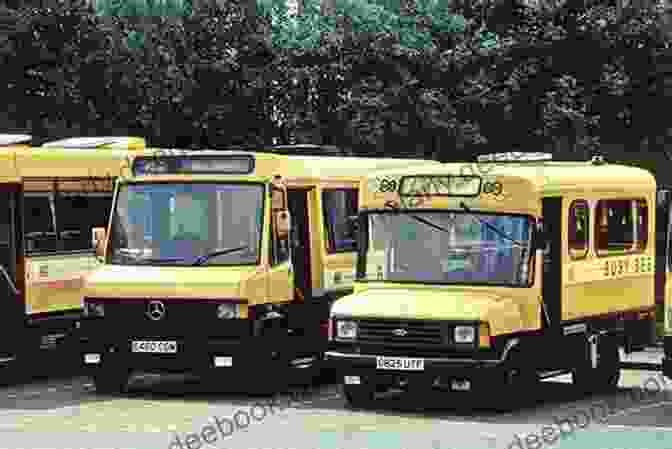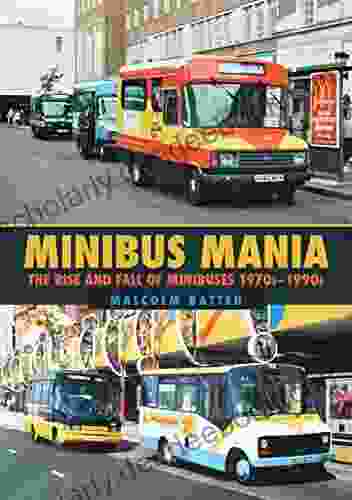The Rise and Fall of Minibuses in the 1970s to 1990s: A Historical Perspective


5 out of 5
| Language | : | English |
| File size | : | 33515 KB |
| Text-to-Speech | : | Enabled |
| Screen Reader | : | Supported |
| Enhanced typesetting | : | Enabled |
| Print length | : | 202 pages |
| Paperback | : | 130 pages |
| Item Weight | : | 9 ounces |
| Dimensions | : | 6 x 0.33 x 9 inches |
Minibuses, those versatile vehicles designed to carry more passengers than a standard car but fewer than a full-sized bus, enjoyed a surge in popularity during the 1970s and 1980s. They became ubiquitous in cities and towns, providing affordable and convenient transportation for commuters, tourists, and families alike. However, their dominance waned in the 1990s, as technological advancements and regulatory changes shifted the transportation landscape. This article explores the rise and fall of minibuses in the 1970s to 1990s, examining their impact on transportation, social mobility, and cultural trends.
Origins and Early Popularity
The concept of a minibus can be traced back to the early 1900s, when various experimental vehicles emerged. However, it was not until the 1970s that minibuses gained widespread acceptance and became a common sight on roads worldwide. This surge in popularity was driven by several factors:
* Fuel crisis: The oil crisis of the 1970s led to increased fuel prices and a growing awareness of fuel efficiency. Minibuses, with their smaller engines and compact designs, offered a more economical alternative to full-sized buses. * Increased demand for transportation: The post-World War II baby boomer generation was coming of age, and urbanization was accelerating. This led to an increased demand for transportation, both within cities and between them. * Deregulation: In the United States, the Motor Carrier Act of 1980 deregulated the bus industry, reducing barriers to entry and allowing new operators to enter the market. This led to increased competition and a proliferation of minibus services.
Types and Designs
Minibuses came in a variety of shapes and sizes, ranging from small, van-like vehicles to larger, bus-like models. They were typically built on the chassis of light trucks or vans, with custom-designed bodies that provided additional seating capacity. Some popular minibus models included the Volkswagen Transporter, Ford Transit, and Mercedes-Benz Sprinter.
The interior of minibuses varied depending on the intended purpose. Some were equipped with comfortable seats and air conditioning, while others were more utilitarian, with simple benches and minimal amenities. They often featured large windows, providing passengers with panoramic views and a sense of spaciousness.
Impact on Transportation
The rise of minibuses had a significant impact on transportation systems worldwide. They provided a flexible and cost-effective way to transport people, filling a niche between traditional buses and cars. Minibuses became particularly popular for:
* Urban transportation: In congested urban environments, minibuses could navigate narrow streets and maneuver through traffic more easily than full-sized buses. They provided a convenient and affordable option for commuters, especially during peak hours. * Suburban and rural transportation: In areas with lower population densities, minibuses played a vital role in connecting suburban and rural communities to urban centers. They offered a more frequent and scheduled service than traditional buses, making it easier for residents to access jobs, education, and other essential services. * Tourism: Minibuses became the preferred vehicle for tour operators, offering a comfortable and intimate way to explore destinations and transport groups of tourists.
Social and Cultural Impact
Beyond their impact on transportation, minibuses also had a social and cultural significance. They became symbols of mobility and freedom, especially for young people and those from lower income backgrounds. Minibuses allowed people to travel further and more frequently, giving them access to new opportunities and experiences.
Minibuses also played a role in cultural movements and countercultures. They were often used as transportation for protests, rallies, and other gatherings. In some communities, minibuses became associated with specific subcultures, such as the reggae and hip-hop scenes.
Decline and Demise
The dominance of minibuses began to decline in the 1990s. Several factors contributed to their downfall:
* Technological advancements: The of new technologies, such as GPS and electronic ticketing systems, made it easier for full-sized buses to operate more efficiently and conveniently. * Regulatory changes: Governments in many countries introduced stricter safety regulations for minibuses, increasing the costs of operating and maintaining them. * Increased competition: As full-sized buses became more efficient and the number of private cars on the road increased, minibuses faced increased competition for passengers.
Legacy and
Minibuses left an enduring legacy on transportation systems and society. They played a crucial role in providing affordable and flexible transportation during a time of rapid urbanization and social change. Their compact size and maneuverability made them well-suited for congested urban environments, while their lower cost of operation made them accessible to a wider range of people.
Despite their eventual decline, minibuses continue to be used in many parts of the world, especially in developing countries. They remain a valuable means of transportation for communities that lack access to reliable public transportation systems. The legacy of minibuses serves as a testament to the important role that small, versatile vehicles can play in meeting the transportation needs of societies.
5 out of 5
| Language | : | English |
| File size | : | 33515 KB |
| Text-to-Speech | : | Enabled |
| Screen Reader | : | Supported |
| Enhanced typesetting | : | Enabled |
| Print length | : | 202 pages |
| Paperback | : | 130 pages |
| Item Weight | : | 9 ounces |
| Dimensions | : | 6 x 0.33 x 9 inches |
Do you want to contribute by writing guest posts on this blog?
Please contact us and send us a resume of previous articles that you have written.
 Novel
Novel Page
Page Chapter
Chapter Text
Text Story
Story Reader
Reader Library
Library Paragraph
Paragraph Glossary
Glossary Foreword
Foreword Preface
Preface Synopsis
Synopsis Footnote
Footnote Scroll
Scroll Codex
Codex Tome
Tome Classics
Classics Biography
Biography Autobiography
Autobiography Memoir
Memoir Encyclopedia
Encyclopedia Dictionary
Dictionary Thesaurus
Thesaurus Character
Character Resolution
Resolution Catalog
Catalog Card Catalog
Card Catalog Archives
Archives Periodicals
Periodicals Study
Study Lending
Lending Reserve
Reserve Academic
Academic Reading Room
Reading Room Special Collections
Special Collections Literacy
Literacy Dissertation
Dissertation Reading List
Reading List Book Club
Book Club Textbooks
Textbooks Darlene Zimmerman
Darlene Zimmerman Jason Hardy
Jason Hardy Suzy Vitello
Suzy Vitello David Garnett
David Garnett Matthew T Corrigan
Matthew T Corrigan Paul Cockshott
Paul Cockshott Stephen Erickson
Stephen Erickson Ann Larabee
Ann Larabee Pat Warren
Pat Warren Barb Solberg
Barb Solberg Robert Beaumont
Robert Beaumont Lexi C Foss
Lexi C Foss Mary Caelsto
Mary Caelsto Arthur Flynn
Arthur Flynn Al Stevens
Al Stevens Ulf Laessing
Ulf Laessing Kristy Caldwell
Kristy Caldwell Marty Godbey
Marty Godbey James Mooney
James Mooney Tori Joel
Tori Joel
Light bulbAdvertise smarter! Our strategic ad space ensures maximum exposure. Reserve your spot today!
 Edwin CoxFollow ·16.8k
Edwin CoxFollow ·16.8k Ignacio HayesFollow ·3.2k
Ignacio HayesFollow ·3.2k Lucas ReedFollow ·3.9k
Lucas ReedFollow ·3.9k T.S. EliotFollow ·12.3k
T.S. EliotFollow ·12.3k Anton FosterFollow ·18k
Anton FosterFollow ·18k Harold PowellFollow ·11.9k
Harold PowellFollow ·11.9k Ralph EllisonFollow ·12.6k
Ralph EllisonFollow ·12.6k José SaramagoFollow ·12.8k
José SaramagoFollow ·12.8k

 Houston Powell
Houston PowellMusorgsky and His Circle: A Russian Musical Revolution
Modest Mussorgsky was a Russian...
 Barry Bryant
Barry BryantRanking the 80s with Bill Carroll: A Nostalgic Journey...
Prepare to embark on a captivating...

 Kelly Blair
Kelly BlairThe Diplomat's Travel Guide to Festivals, Holidays, and...
India is a land of vibrant culture and...

 José Saramago
José SaramagoFancy Nancy Nancy Clancy: Late-Breaking News!
Nancy Clancy is back with all-new adventures...

 Trevor Bell
Trevor BellGestalt Psychotherapy and Coaching for Relationships: A...
Relationships...

 Federico García Lorca
Federico García LorcaThe Last Love of George Sand: An Enduring Legacy of...
At the twilight of her remarkable life,...
5 out of 5
| Language | : | English |
| File size | : | 33515 KB |
| Text-to-Speech | : | Enabled |
| Screen Reader | : | Supported |
| Enhanced typesetting | : | Enabled |
| Print length | : | 202 pages |
| Paperback | : | 130 pages |
| Item Weight | : | 9 ounces |
| Dimensions | : | 6 x 0.33 x 9 inches |












